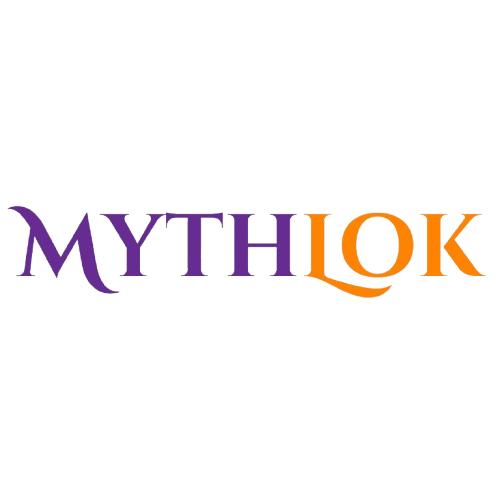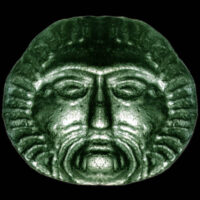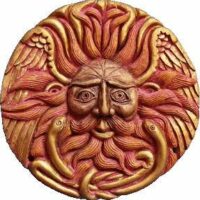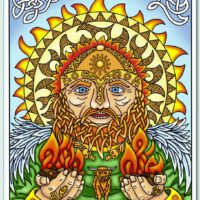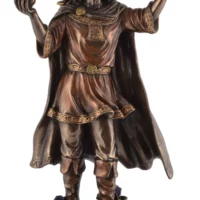Belenus : God of Healing
Listen
At a glance
| Description | |
|---|---|
| Origin | European Mythology |
| Classification | Gods |
| Family Members | N/A |
| Region | France, Britain, Ireland, Italy, Spain, Portugal |
| Associated With | Sun, Healing, |
Belenus
Introduction
Belenus, often called Belenos or Belinus, holds a special place in the ancient Celtic pantheon. Celebrated especially in Gaulish and Breton traditions, he was revered as a radiant symbol of the sun, healing, and vitality. His name, believed to mean “bright” or “shining one,” reflects his association with light and life. Worship of Belenus extended far and wide—from northern Italy through Noricum and Gaul to the British Isles—revealing his deep-rooted cultural importance across Celtic Europe. Unlike other solar deities absorbed by Roman mythology, Belenus preserved a uniquely Celtic character, connected closely with the rhythms of nature, health, and agriculture.
Physical Traits
Although historical records don’t offer elaborate depictions of Belenus, the imagery tied to his name brings to life a luminous and vigorous figure. Artistic interpretations often surround him with symbols of light, including rays, flames, or solar halos. He is imagined as eternally youthful, embodying the warmth and energy of midsummer. In some artwork, he appears alongside a female figure—possibly the goddess Belisama—hinting at a divine partnership that echoes themes of balance and fertility. Notably, a 1st-century coin portrays him with bold features, a radiant crown of hair, and large, striking eyes, reinforcing his solar identity.
Family
There is limited direct reference to Belenus’s lineage or offspring in mythological texts, but connections have been drawn between him and other deities. Some traditions link him to Belisama, a goddess of fire and light, suggesting a divine consort or counterpart. Scholars also point to a possible relationship with Beli Mawr, a Welsh ancestral figure, though interpretations vary. These mythic associations paint Belenus not only as a solitary god but as a vital part of a broader spiritual ecosystem in Celtic belief.
Other names
Belenus was worshipped under various names across different Celtic-speaking regions. Depending on the location and dialect, he was known as Belenos, Belinus, Bel, Beli, or even Bile. These variations speak to his widespread reverence and the linguistic diversity of ancient Celtic peoples. Under Roman influence, he was often equated with Apollo, a reflection of the shared themes of light, healing, and prophecy. Yet, Belenus’s unique attributes and local customs helped retain his distinctly Celtic identity.
Powers and Abilities
Central to Belenus’s character is his dominion over light, health, and rejuvenation. More than just a solar figure, he was believed to possess healing powers, often linked to sacred springs and therapeutic waters. Communities built shrines near these thermal sites, where people would seek relief from illness under his blessing. His energy was thought to chase away darkness—both literal and metaphorical—bringing clarity, vitality, and protection. In agricultural life, Belenus played a crucial role in ensuring fertile lands and thriving crops, making him a guardian of seasonal cycles and rural prosperity.
Modern Day Influence
Though centuries have passed since his temples stood in Gaul or Noricum, Belenus’s legacy quietly endures. Modern neopagan movements often invoke him as a symbol of solar energy and healing. The Beltane festival, rooted in ancient Celtic rites, continues to be celebrated in parts of Ireland and Scotland. These fire rituals honor the return of warmth and life, echoing Belenus’s spirit of renewal. Beyond spiritual circles, his name lives on in popular culture—appearing in literature, games, and even astronomy, with asteroid 11284 Belenus carrying his name across the stars. His enduring myth reminds us of our ancient reverence for the sun, health, and the balance of nature.
Related Images
Source
Green, Miranda J. The Celtic World. Routledge, 1995.
MacKillop, James. Dictionary of Celtic Mythology. Oxford University Press, 1998.
Ellis, Peter Berresford. Celtic Myths and Legends. Running Press, 2002.Cunliffe, Barry.
The Ancient Celts. Oxford University Press, 2003.Koch, John T.
Celtic Culture: A Historical Encyclopedia. ABC-CLIO, 2006.Nash, Michael.
Celtic Mythology and Religion. BiblioBazaar, 2009.
Ancient History Encyclopedia: https://www.worldhistory.org
Encyclopedia Mythica: https://pantheon.org
Celtic Mythology Online: https://www.celticmythology.com
Frequently Asked Questions
What is lorem Ipsum?
I am text block. Click edit button to change this text. Lorem ipsum dolor sit amet, consectetur adipiscing elit. Ut elit tellus, luctus nec ullamcorper mattis, pulvinar dapibus leo.
What is lorem Ipsum?
I am text block. Click edit button to change this text. Lorem ipsum dolor sit amet, consectetur adipiscing elit. Ut elit tellus, luctus nec ullamcorper mattis, pulvinar dapibus leo.
What is lorem Ipsum?
I am text block. Click edit button to change this text. Lorem ipsum dolor sit amet, consectetur adipiscing elit. Ut elit tellus, luctus nec ullamcorper mattis, pulvinar dapibus leo.
What is lorem Ipsum?
I am text block. Click edit button to change this text. Lorem ipsum dolor sit amet, consectetur adipiscing elit. Ut elit tellus, luctus nec ullamcorper mattis, pulvinar dapibus leo.
What is lorem Ipsum?
I am text block. Click edit button to change this text. Lorem ipsum dolor sit amet, consectetur adipiscing elit. Ut elit tellus, luctus nec ullamcorper mattis, pulvinar dapibus leo.

